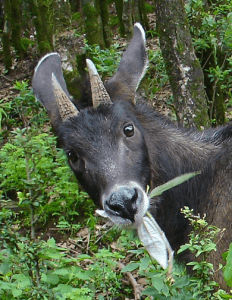TAG: GS 3: ECOLOGY AND ENVIRONMENT
THE CONTEXT: The recent photographic evidence of the elusive Mainland Serow (Capricornis sumatraensis thar) in Assam’s Raimona National Park marks a remarkable achievement in wildlife conservation.
EXPLANATION:
- This discovery, facilitated by forest officials and the biodiversity group Aaranyak, underscores the park’s pivotal role in preserving rare species and highlights the broader ecological implications for the region.
- For the first time, the Mainland Serow has been captured on camera in Raimona National Park.
- The sighting was documented near the Ganda Bajrum Anti-poaching camp using strategically placed digital camera traps in the park’s western region.
- This breakthrough provides crucial data for conservationists and marks a significant milestone in the park’s biodiversity records.
Ecological and Conservation Importance
- The Mainland Serow’s habitat range extends from the Himalayas to Sumatra, encompassing diverse ecological zones.
- This species also inhabits Bhutan’s Royal Manas National Park and the Phibsoo Wildlife Sanctuary, highlighting the potential for cross-border conservation collaborations.
- The species’ fragmented populations and the urgent need for conservation measures due to threats like poaching and habitat destruction has been emphasised.
Raimona National Park
- Raimona National Park is located in Assam’s Kokrajhar district.
- It was declared a national park on June 5, 2021, by Assam’s Chief Minister during World Environment Day celebrations.
- The park is renowned for its rich biodiversity, featuring tropical forests, grasslands, and wetlands.
- It serves as a sanctuary for various endangered and vulnerable species, including the golden langur, which is endemic to the region and the mascot of the Bodoland area, shared with Bhutan.
Conservation and Ecotourism
- Managed by the Assam Forest Department, Raimona National Park plays a critical role in wildlife conservation efforts.
- The park offers visitors the opportunity to engage in ecotourism, contributing to ongoing preservation initiatives.
- The recent documentation of the Mainland Serow not only highlights the park’s ecological significance but also reinforces the importance of sustained conservation efforts to protect and preserve the diverse wildlife and habitats of the region.
Himalayan serow (Capricornis sumatraensis thar)
- The Himalayan serow (Capricornis sumatraensis thar), also known as the thar is a subspecies of the mainland serow native to the Himalayas.
- It was previously considered its own species, as Capricornis thar.
- Traditionally, the mainland serow is known to inhabit regions at altitudes between 200 and 3,000 meters above mean sea level.
- However, this recent observation recorded the animal at a mere 96 meters above mean sea level, far beyond its usual altitudinal range and closer to human habitation than previously documented.
- It is the official state animal of the Indian state of Mizoram.
- Capricornis sumatraensis is listed in CITES Appendix I.
- It has been categorized as Vulnerable as per the IUCN Red List.

SOURCE: https://www.mypunepulse.com/mainland-serow-spotted-in-assams-raimona-national-park/
Spread the Word



